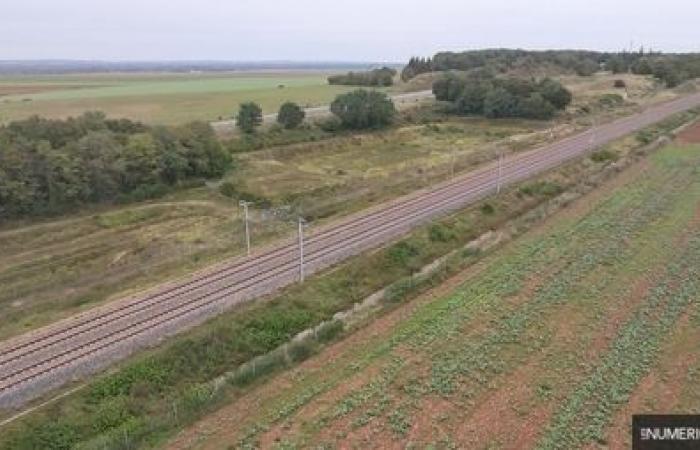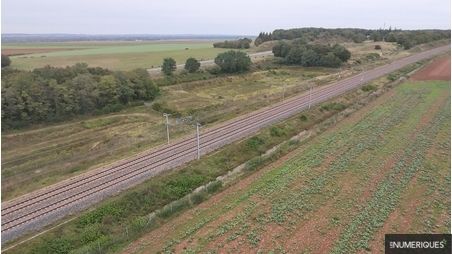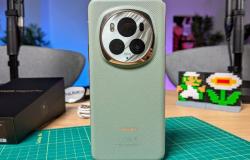DJI has accustomed its customers to the great ease of use of most of its drones. Very advanced piloting assistance, automation that would almost make a beginner look like an experienced pilot: DJI’s onboard technologies allow any novice to take to the air while enjoying real piloting pleasure. The Neo is a concentrate of all the know-how of the Chinese manufacturer in a small 135 g machine capable of flying without accessories and taking off/landing in the palm of the hand.
The DJI Neo is sold alone at a price of €199. The box includes the drone, a smart flight battery, a pair of propellers (screws included), a screwdriver, a gimbal guard, and a USB-C to USB-C cable.
DJI Neo Kit Fly More.
© DJI
The DJI Neo Fly More bundle (DJI RC Motion 3) retails for €349. This bundle includes a drone, a DJI RC Motion 3 remote control, three intelligent flight batteries, a pair of propellers (screws included), a screwdriver, a gimbal guard, a USB-C to USB-C PD cable, a cable USB-C, a DJI Neo two-way charging station and a shoulder bag.

Getting started
The small DJI Neo has a very small size with dimensions of 15.7 x 13 x 4.9 cm and a very light weight of 135 g. Its appearance is very close to that of the Avata 2 with carbon manufacturing with very rounded shapes.
The Neo’s four propellers are protected by effective grilles which allow it to be placed and taken off in the palm of the hand, without risk of injury. Dismantling and reassembling the propellers involves removing these small grids by unclipping the five lugs that hold them. Please note, there are no coding on the propellers, but a marking on two of the motors and the corresponding propellers.
© Romane Riesse / Les Numériques
© Romane Riesse / Les Numériques
© Romane Riesse / Les Numériques
At the front, the drone camera is mounted on a gimbal stabilized on a single axis, protected by a cover for transport. Coupled with RockSteady or HorizonBalancing stabilization technologies, the Neo is capable of compensating image shakes and correcting the tilt of the horizon up to ±45°.
© Romane Riesse / Les Numériques
The rear of the drone reveals the USB-C port needed for recharging the battery, as well as connecting to a computer to offload its 22GB internal memory. Don’t look for a microSD card slot, as it doesn’t there are none. 22 GB is nevertheless up to 40 min of 4K/30 fps video or 55 min of 1080p/60 fps video. The transfer of images can also be carried out on a smartphone via wifi via the DJI Fly app.
© Romane Riesse / Les Numériques
The DJI Neo is clearly intended for vloggers and all amateurs wishing to share their exploits, without having to master complex flight techniques. Different methods are available. The simplest requires no smartphone or radio control, but thanks to six automatic commands (QuickSHots) directly from the drone. It is accessed by selecting icons located on the top of the drone via a small button.
Each command is described vocally (in English); simply press the button for a few seconds after selecting the mode to engage the drone in its automatic flight procedure. These six modes offer a variety of movements and different shooting angles:
- Dronie: The drone flies backwards and performs an ascent. With the camera locked on the subject, it records video.
- Circle: the drone rotates around the subject.
- Rocket: The drone performs an ascent with the camera pointed downward.
- Spotlight: The drone rotates while keeping the object of interest in its frame.
- Spiral: The drone ascends and spirals around the subject.
- Boomerang: The drone flies around the subject in an oval trajectory, ascending away from its initial point and descending when returning.
Control directly from the DJY Fly app.
© Romane Riesse / Les Numériques
The DJI Neo can be controlled from a smartphone with the DJI Fly app. Practical if you do not want to carry a radio control and allows the drone to be flown in its standard configuration (without said radio control). A wifi connection with the smartphone allows you to control the Neo using virtual joysticks on the app interface with a control range of up to 50 m. The app also allows you to adjust the tracking angle and distance. More conventional, a radio control manages the piloting of the Neo, like any drone, while benefiting from access to all automatic flight modes.
© Romane Riesse / Les Numériques
Paired with the RC-N3 remote control, DJI announces a video transmission distance of the Neo of up to 10 km and offers the possibility of operating the camera using joysticks for professional shots. Keep in mind that French legislation requires a direct view of the drone. The small DJI device can also be paired with the DJI Goggles 3 or the 3 FPV radio control.

Vol
Our first test phases focused on using the DJI Neo alone, without radio or smartphone, relying on all the automations accessible from the drone. A successful bet for the manufacturer with easy access to the six automated figures which, without the assistance of algorithms and the power of on-board AI, would require many hours of learning for a beginner pilot. Simple as pie, the system relies on recognition of the user’s face. The latter chooses the function and little Neo takes off and lands in the palm of his hand safely. It’s quite stunning and disconcertingly easy. The figures are symbolized by small pictograms: impossible to make a mistake, even if they are stated in English.
© Romane Riesse / Les Numériques
After each use and with any function, the Neo returns to hover where it took off. All you have to do is hold out your hand for him to come and lay on it. It’s hard to make it simpler and more accessible to anyone. For information, tracking is carried out at low speed, which is interesting in the case of a subject on foot or cycling at low speed. If the subject being followed is too fast, the DJI Neo stalls and hovers.
With a smartphone and the DJI Fly app, the drone can be piloted by hand or with the same automated functions as those available without a smartphone or radio control. This possibility is not very pleasant to use, the DJI Fly interface being surprisingly in vertical mode. The video feedback is very small with only a few indications regarding telemetry, access to automatic modes and two virtual joysticks.
© Romane Riesse / Les Numériques
These virtual joysticks, less precise than those of a real radio control, nevertheless allow you to manually position the height of the drone to modify the framing. In this mode, the range of the DJI Neo is approximately 15 to 20 m with a clear degradation of the signal beyond this distance, even in open terrain. The Neo has the RTH (Return To Home) function which will allow it to be automatically returned to its starting point in complete safety in the event of total loss of signal.
© Romane Riesse / Les Numériques
The little Neo will also be operational with a smartphone and a radio control, like the RC-N3 provided in the FlyMore kit that we tested. In this context of use, the Neo is piloted like any DJI drone, this time with the classic DJI Fly interface. Flights can be carried out in the same way as with a Mavic, a Mini or an Air, always with this assistance and piloting comfort specific to DJI drones.
The big difference comes both from the small size of the Neo and its weight. This does not offer the same ease once in the air in degraded flight conditions, as was the case during our tests. Once in the air, depending on the different levels to which we took it, the drone has difficulty withstanding the gusts of wind, strongly tossed around, particularly at 120 m, a ceiling where the alerts on the radio control greatly encouraged us to bring the Neo back to its starting point otherwise you will completely lose control.
© Romane Riesse / Les Numériques
At this ceiling, observed in a stationary state, the drone moves with the wind and becomes impossible to pilot correctly. You can’t have everything… This small size, however, allows the Neo to be easily driven in places where even a Mini or an Avata would not pass. Its light weight and protection allow it to withstand shocks without damage as long as you don’t ride it like a savage.
© Romane Riesse / Les Numériques
In this piloting configuration with radio control, DJI highlights a range of up to 6 km. You can imagine that we have not tested this possibility and for several reasons, the first of which concerns French legislation which requires a direct view of the drone. The second, more obvious: the Neo is so small that in gray weather – as was the case during all our tests – we lose sight of it very quickly. You will have to listen and widen your eyes to find it.

Image quality
Tested in fairly poor weather conditions (gray weather, fairly violent gusts), the Neo undoubtedly did not provide the best of what it is capable of producing, given our test images. Its camera has a 1/2-inch sensor covering a range of ISO 100 to 6400 and a shutter speed ranging from 1/8000 sec to 1/30 sec. This camera is mounted on a gimbal mechanically stabilized on one axis with control from -90° to 60°. The 12 Mpx images (4000 x 3000 pixels in 4:3 and 4000 x 2256 pixels in 16:9) are in jpg format without Raw possible, because it is indeed a consumer drone.
On the video side, the Neo films in 4K at 30 fps (3840 x 2160 pixels) and in 1080p up to 60 fps, which is quite good for general public use.
7 images
Images taken with the DJI Neo drone – © Romane Riesse
But as we were able to see during our tests, the quality is not very comfortable in low light, with somewhat dull images, quite present noise, especially in dark areas, all with pixelation very notable. Observations visible in photo mode and especially in video.
This Neo was buffeted a lot by the wind during our tests; many of our photos taken while stationary are even blurry, and in the case of certain video sequences, the mechanical stabilization of the gimbal assisted by digital stabilization (RockSteady and HorizonBalancing) did not succeed in producing very large images. fluidity. Given the Neo’s small size and light weight, we expected it.
So, yes, we tested the Neo in a very degraded situation, but which allows us to show the limits of its small sensor in difficult flight and light conditions. The Neo will therefore be most at ease in good lighting conditions and without too much wind.
© Romane Riesse / Les Numériques

Autonomy
Manufacturers are usually very optimistic about the autonomy of their products. That said, DJI has always been fairly reliable with numbers generally sticking close to what we were seeing in the field. Alas, the promise of 17 minutes with the Neo remains very far from our observations.
So, yes, the weather conditions, particularly the wind, were not very kind, but without forcing the throttle, none of our batteries (three in total with the Fly More kit) lasted beyond 10 min. In its basic version, the Neo is supplied with a single battery, it is very light and we can only recommend purchasing the Fly More kit to hope to fly for at least thirty minutes each outing.









